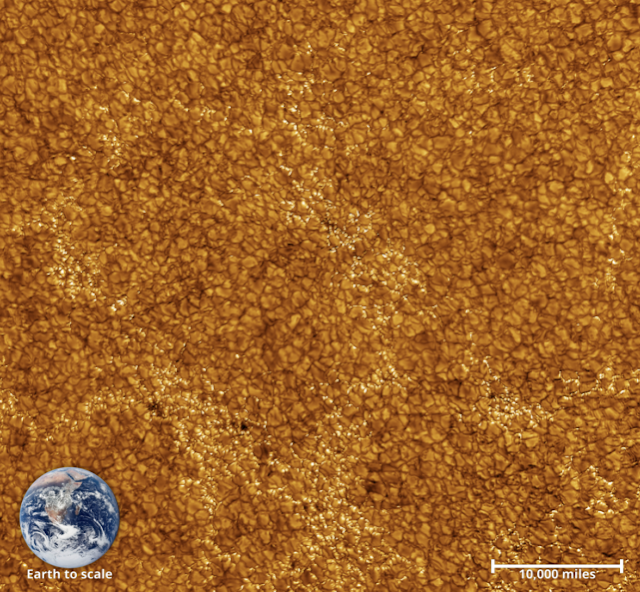A brand-new image from the most potent solar telescope in the world shows the face of our Sun in amazing detail. The middle layer of the Sun's atmosphere, known as the chromosphere, seems almost like a shag rug when viewed up close at a resolution of only 18 kilometers.
The image above shows scorching plasma streaming into the corona from what is more clearly seen in the image below as a pattern of pores resembling a honeycomb. Each of these granules, or blistering blobs, measures around 1,600 kilometers (994 miles) in width. Each of these images is only a small fraction of the Sun's entire diameter at 82,500 kilometers (51,260 miles) broad. Astronomers have scaled up our own planet to put into perspective the enormous size of these photographs.
The astounding accomplishment, which comes to fruition after 25 years of painstaking planning, commemorates the first anniversary of the Inouye Solar Telescope, the most potent instrument of its type. Only during a total solar eclipse can one see the Sun's chromosphere, which is located below the corona and obscures the star by forming a crimson rim around it. But that has changed with modern technology.
We have never before looked so closely at the light source of our Solar System. The Manhattan island-sized characteristics of the Sun's chromosphere can be seen via the Inouye telescope. Solar scientist Jeff Kunh hailed the nearly completed telescope's first photographs from last year as "the greatest jump in humanity's ability to study the Sun" since Galileo.
We have now inaugurated a "new era of Solar Physics," according to astronomer and space telescope scientist Matt Mountain, head of the Association of Universities for Research in Astronomy (AURA). The knowledge gathered from this unique viewpoint may aid scientists in forecasting and preparing for solar storms, which have the potential to send a tsunami of hot plasma and magnetism from the Sun's corona to Earth, possibly resulting in months-long worldwide blackouts and internet outages.
The National Science Foundation (NSF) and the US Congress for their ongoing support, as well as the Inouye Solar Telescope Team, many of whom have painstakingly dedicated over a decade to this transformational project, are especially appreciated, Mountain stated in a recent announcement.
On Haleakal, the Maui volcano that is significant to Native Hawaiian culture and spirituality, the Inouye Solar Telescope was constructed. While the NSF is delighted to have included local Hawaiian participation in the telescope's design, some native Hawaiians think the object still feels like an insult from white invaders.
Native Hawaiians are fiercely opposing the construction of another enormous telescope on Maunakea because they don't want their sacred land torn up for the advancement of western science. It is obvious that the Inouye Solar Telescope is a significant scientific accomplishment for contemporary astronomers, but it has a cultural cost to an earlier group of scientists.
Native Americans used the Sun, Moon, and stars to better understand our place in the universe long before Galileo. We now have a unique opportunity to view the center of our Solar System thanks to the Inouye Solar Telescope, but as our field of vision grows smaller, we must not forget the astronomers who came before us. We can see the stars more clearly when we stand on their shoulders.
Reference: Research in Astronomy (AURA)





.png)
%20(1)%20(2).jpg)
0 Comments